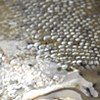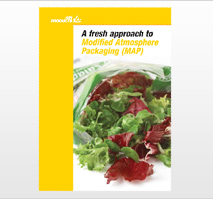Cooked, Cured, Processed Fish and Seafood Products

Food items: Bloaters, Bombay Duck, Buckling, Cod's Roe, Cold Smoked Fish, Fish Galantine, Fish Rillettes, Fish Terrines, Hot Smoked Fish, Kippers, Potted Fish, Potted Shellfish, Salt Cod, Salted Anchovies, Salted Caviar, Salted Fish Roes, Salted Jellyfish, Seafood PÔtÚs, Smoked Haddock, Smoked Halibut, Smoked Mackerel, Smoked Salmon, Smoked Trout, Taramasalata, other items
Recommended gas mix
Storage temperature Achievable shelf-life Principle spoilage organisms and mechanics Food poisoning hazards include |
Typical MAP machines Typical types of package Examples of typical MAP materials Lidding and/or pillow
pack film: Bulk |
 The principal spoilage mechanisms for cooked, cured and processed fish and seafood products are microbial growth and oxidative rancidity. For cooked products, the heating process should kill vegetative bacterial cells and inactivate degradative enzymes. Consequently, spoilage of cooked fish and seafood products is primarily due to post-cooking contamination by micro-organisms and oxidative rancidity which can be minimised by MAP with CO2/N2 mixtures and good hygiene and handling practices. A gas/product ratio of 2:1 is recommended.
The principal spoilage mechanisms for cooked, cured and processed fish and seafood products are microbial growth and oxidative rancidity. For cooked products, the heating process should kill vegetative bacterial cells and inactivate degradative enzymes. Consequently, spoilage of cooked fish and seafood products is primarily due to post-cooking contamination by micro-organisms and oxidative rancidity which can be minimised by MAP with CO2/N2 mixtures and good hygiene and handling practices. A gas/product ratio of 2:1 is recommended.
Cured and processed fish and seafood products contain relatively high levels of salt which effectively inhibits a wide range of spoilage micro-organisms. Cooked, cured and processed fish and seafood products contain high levels of unsaturated fat which is prone to oxidative rancidity. However, MAP with
CO2/N2 mixtures is effective at inhibiting such undesirable oxidative rancidity. Possible food poisoning hazards are primarily due to post-cooking, curing or processing contamination which can be minimised by maintenance of recommended chilled temperatures and good hygiene and handling practices.
The reduced aw and/or addition of salt in most cooked, cured and processed fish and seafood products inhibit most food poisoning bacteria, particularly Clostridium botulinum. This inhibition may be compromised in products formulated with lower salt or other preservatives as is becoming increasingly popular. Caution must be exercised to assess the potential effects of any changes in product formulation. Simple cooked fish and seafood products without any added preservatives are likely to be at greater risk from growth of Clostridium botulinum under anaerobic MAP conditions and incorrect chilled storage.




